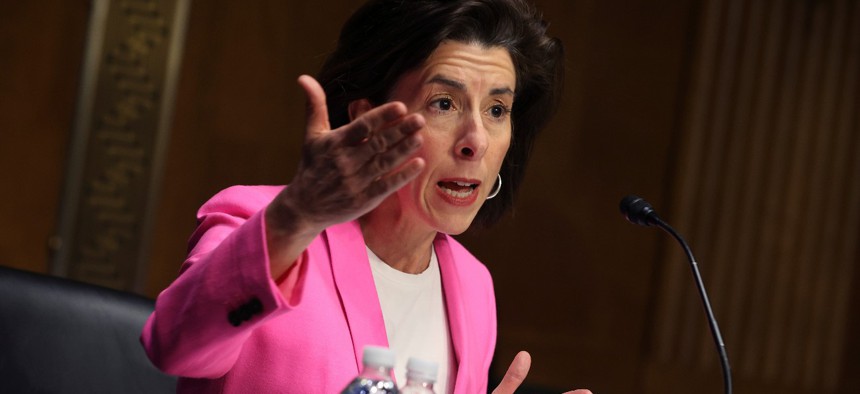
“I trust these experts and I’m confident in this work,” said Commerce Secretary Gina Raimondo. Chip Somodevilla/Pool via AP
As Bureau Delivers Data, Officials Praise 'Dedicated Civil Servants' Who Ensured Accurate Census Despite 'Obstacles'
A pandemic and legal battles threatened to upend the decennial count.
The U.S. Census Bureau unveiled its state-by-state apportionment data on Monday, laying out the population totals after unprecedented disputes over the proper role of the decennial count and delays caused by the COVID-19 pandemic.
Agency leaders praised the work of career employees who overcame those hurdles, noting they had to adjust long-planned processes on the fly and constantly adjust to various lawsuits and top-down mandates. The bureau missed its Dec. 31, 2020 deadline to deliver the data after pausing its count when the COVID-19 outbreak first began, but quickly resumed with altered protocols and ended its enumeration in mid-October. That process followed a lengthy legal battle in which the Trump administration had sought to end the count earlier, but a federal judge required the effort to continue. Ultimately, the Supreme Court intervened and allowed Census to cease its field operations.
Commerce Secretary Gina Raimondo, whose department includes the bureau, praised Census’ “dedicated civil servants” who overcame hurdles to “conduct a complete and accurate census count.” She noted that despite the setbacks and controversies, the statisticians at the bureau ensured all the data were delivered without issue.
“I trust these experts and I’m confident in this work,” Raimondo said, adding she told President Biden the census was successful.
Last year, Census officials, former Commerce Secretary Wilbur Ross and President Trump initially said it would not be possible to meet the Dec. 31 deadline to deliver data from the count due to pandemic-instituted delays. Those setbacks caused Census to develop a new plan that involved counting through Oct. 31 and delivering data in April 2021, but then the Trump administration subsequently changed those deadlines to Sept. 30 and Dec. 31, respectively. Watchdogs, including the Commerce inspector general and the Government Accountability Office, found the truncated timetable for counting risked an incomplete and inaccurate count. The Trump administration argued that it had to meet its statutory obligation to deliver data by the end of 2020, but career officials at the bureau ultimately succeeded in pushing back the delivery date anyway.
The back and forth created confusion and chaos among the hundreds of thousands of Census employees in the field, who reported receiving divergent messaging that may have conflicted with the court’s order. The timing disputes followed lawsuits over whether the Trump administration could add a citizenship question to the census questionnaire and remove non-citizens from apportionment data. Neither effort was ultimately successful.
Ron Jarmin, the acting Census Bureau director, told Government Executive on Monday the Trump administration's priorities were "never that big" of an issue. Trump officials were helpful to the bureau "in some ways," added Jarmin, a career Census employee since 1992, and each presidential administration is "always a mixed bag."
"The citizenship question and wanting to exclude some people from apportionment, those were distractions and caused some folks on the staff to have to deal with legal cases and what have you," Jarmin said. "But by and large, operationally, we were able to keep the folks who were actually doing the census focused on their work."
The bureau was in a rare position of sorting through its decennial data in the midst of a transfer of power, as apportionment data is typically delivered prior to inauguration. Jarmin said a strong leadership team kept the bureau running smoothly, as it did during all of last year's hurdles.
"The Census Bureau has an amazing career staff of smart, innovative, creative professionals that also believe deeply in the mission," Jarmin said, adding they had instituted the planning and investments that made dealing with turbulence possible. "Without this great team, we never would have been able to accomplish the census even under the best of conditions."
Census officials noted how dramatically they had to upend their plans due to the pandemic, from shifting their marketing plans to distributing personal protective equipment and altering how enumerators knocked on doors. Jarmin suggested that as recently as 2010, the bureau would not have been able to carry out its count under 2020's conditions. As for the results, the U.S. population grew by just 7%, the second-lowest rate in any decennial count. Texas, Colorado, Oregon, Montana, Florida and North Carolina will all gain at least one seat in the House, while California, Illinois, Michigan, Ohio, West Virginia, Pennsylvania and New York will all lose one.
Rep. Carolyn Maloney, D-N.Y., who chairs the House Oversight and Reform Committee, praised the bureau for its work in the face of significant difficulties.
“The Census faced unprecedented obstacles, including pernicious efforts by former President Trump to hijack the Census for political gain—such as illegal attempts to add a citizenship question, exclude immigrants from the count, and rush data analysis despite the risk of errors—as well as delays and operational changes caused by the coronavirus pandemic,” Maloney said.
Bureau employees will still be hard at work in the months to come, facing deadlines to deliver data for specific redistricting and the allocation of trillions of dollars doled out by federal agencies. The redistricting data is expected by the end of September.







